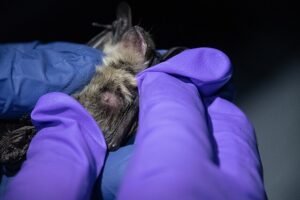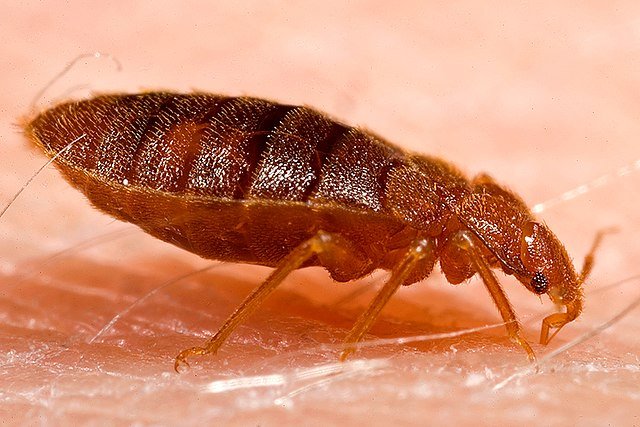Bat Bugs (Cimex adjunctus): The Hidden Bed Bug Lookalikes in Your Home
 If you’ve ever spotted a small, flat, brown bug crawling on your bed and thought “bed bugs,” you might be wrong — it could be a bat bug (Cimex adjunctus).
If you’ve ever spotted a small, flat, brown bug crawling on your bed and thought “bed bugs,” you might be wrong — it could be a bat bug (Cimex adjunctus).
Sometimes it had happened to clients panic over what they thought was a bed bug infestation, only to discover the real culprits were these close relatives that live on bats. Bats that had been living unnoticed in the attic or the lights of the balcony.
Bat bugs look almost identical to bed bugs (Cimex lectularius) and feed on blood the same way — but they prefer bats, not humans. When bats leave their roost, though, these bugs lose their main food source and crawl into living spaces, searching for new hosts.
Understanding the difference between bat bugs and bed bugs is key. The control method changes completely depending on which one you have.
Identification
Bat bugs belong to the same family (Cimicidae) as bed bugs, swallow bugs, and poultry bugs, all of which feed on warm-blooded hosts.
What They Look Like
Oval, flat body, reddish-brown color.
Size: about 4–5 mm long when unfed, swelling after feeding.
Six legs and short antennae.
No wings, but good crawlers.
The main physical difference from bed bugs is in the longer fringe hairs on the thorax — visible only under a microscope or magnifier.
Because of this, most homeowners and even inexperienced technicians mistake bat bugs for bed bugs. Correct identification usually requires lab confirmation or an experienced pest control professional.
Biology and Ecology
Bat bugs are temporary ectoparasites — they live near their bat hosts, not directly on them.
They hide in cracks, wood joints, roof tiles, insulation, and other dark, protected spaces where bats roost.
Feeding habits:
Prefer the blood of bats.
Can feed on humans if bats are gone.
Can survive months without feeding.
Females lay eggs near the roosting sites, and the full life cycle (egg to adult) takes around 6–8 weeks depending on temperature and humidity.
Just like bed bugs, bat bugs inject saliva containing anticoagulants and anesthetics, which allow them to feed unnoticed.
Global Distribution
Bat bugs are found across the world, especially where bats live close to human structures.
They’re common in:
North America (especially the Midwest and Northeast)
Europe (in attics, barns, and old buildings)
Asia and Australia (in tropical bat roosts near houses)
They typically infest attics, chimneys, barns, and old houses, especially those with cracks leading to human areas.
Urban pest control professionals often encounter them after roof renovations or attic cleanouts — when displaced bats leave behind hungry bugs.
Risks and Damage
Bat bugs don’t transmit known diseases to humans, but their bites cause severe itching and allergic reactions in sensitive individuals.
More importantly, an undiagnosed bat bug infestation usually means a hidden bat colony somewhere in the building.
Typical risks include:
Repeated bites similar to bed bugs.
Staining on walls and bedding from crushed bugs or droppings.
Psychological stress, insomnia, and fear of reinfestation.
Secondary pest infestations, bats can also carry fleas, ticks, and bird mites.
I’ve seen homeowners spend hundreds of euros treating “bed bugs” with no success, only to find bat droppings above their bedroom ceiling — the true source of the infestation.
Signs of Infestation
Bat bugs are extremely cryptic, but there are several signs that can help you identify their presence:
Small, flat brown insects found near windows, lights, or ceilings — usually in upper floors.
Bat droppings (guano) or strong ammonia smell from attics or chimneys.
Bite marks on humans (clusters or straight-line bites, similar to bed bugs).
Rust-colored stains on walls or bedding from crushed bugs.
Sightings of bats entering or leaving the roof, attic vents, or eaves at dusk.
If bats are present, it’s almost certain that bat bugs are too — even if you can’t see them.
Control Methods
1. Remove the Source (Bats)
No treatment will succeed if bats remain inside the structure.
Work with wildlife control professionals to safely and legally remove them, as bats are protected species in many countries.
After exclusion, seal all entry points with mesh or caulk to prevent re-entry.
2. Clean and Vacuum Thoroughly
Once the bats are gone, vacuum all visible bugs, droppings, and debris from roosting areas, ceilings, and attics.
Use a HEPA-filtered vacuum and dispose of the bag immediately.
3. Apply Insecticides (Professional Use Only)
Treat cracks, crevices, and wall voids near roosting sites using residual insecticides approved for crawling insects.
Common active ingredients include pyrethroids (e.g., deltamethrin, lambda-cyhalothrin) or silica gel dusts for long-term control.
Never spray open ceilings or air ducts. Chemical applications should be done only by licensed pest control professionals.
4. Heat Treatments
In severe infestations, localized heat treatments (50–60°C for several hours) can kill all life stages, including eggs, without chemicals.
5. Structural Sealing
Seal cracks around light fixtures, window frames, and ceiling edges to block migration paths from the attic to the living area.
6. Mattress and Furniture Management
If bugs have entered bedrooms, use encasements for mattresses and box springs — the same way you’d handle bed bugs.
Wash and heat-dry bedding, curtains, and clothing at over 60°C.
Advanced Approaches
Professional pest control teams often combine multiple methods into an Integrated Pest Management (IPM) plan:
Thermal imaging to locate bat roosts and migration paths.
Aerosol dusts or microencapsulated formulations for deep wall voids.
Residual barrier treatments around attic openings.
Post-exclusion monitoring to detect re-infestation.
In commercial buildings or schools, coordination with wildlife specialists and environmental health officers is crucial for legal compliance.
Cultural and Historical Context
Bat bugs have been recorded since ancient times, but were often confused with bed bugs until the early 20th century.
In medieval Europe, “bed bugs from the rafters” were blamed on poor hygiene — not realizing they came from bats nesting above sleeping quarters.
Even today, the confusion continues. I’ve been called to hotels, schools, and old monasteries where both bats and humans share walls — and the two bug species co-exist, switching hosts depending on availability.
In fact, modern bed bugs (Cimex lectularius) are believed to have evolved from ancient bat parasites that adapted to human environments thousands of years ago.
FAQ
Q1: Do bat bugs bite humans?
A: Yes, they can bite people if their bat hosts are gone. The bites look and feel just like bed bug bites.
Q2: How can I tell the difference between bat bugs and bed bugs?
A: Only a trained professional or lab can tell for sure — bat bugs have longer thoracic hairs under magnification.
Q3: Are bat bugs dangerous?
A: They don’t spread diseases, but their bites can cause allergic reactions and severe itching.
Q4: Will pest sprays for bed bugs work on bat bugs?
A: Yes, most insecticides will kill both species — but if you don’t remove the bats, they’ll come back.
Q5: Can bat bugs infest pets?
A: No, they don’t live on pets. But they might bite them if bats are gone and no human hosts are available.
Q6: Do bat bugs fly or jump?
A: No. They can only crawl, but they move surprisingly fast across ceilings and walls.
Final Thoughts
In my years as a pest control technician, I’ve seen dozens of “bed bug” infestations that turned out to be bat bugs. The surprise on the homeowners’ faces is always the same — they’ve treated their mattresses, sprayed chemicals, and spent money on heat treatments, yet the problem kept coming back.
That’s because the real infestation usually hides above your head — in the attic, the roof gaps, or behind the walls where bats roost. Until those bats are removed and the structure is sealed, the bugs will keep returning.
The truth is, bat bugs are not dirty-home pests. They appear even in clean, renovated houses if bats find a way in. So don’t panic — this is a wildlife and pest management issue, not a hygiene problem.
If you suspect bat bugs, don’t start spraying blindly.
First, confirm whether bats are present. If yes, contact a licensed wildlife control specialist for exclusion, and then call a certified pest control professional for follow-up treatments.
For hotels, schools, and older buildings, regular attic inspections and exclusion work save both reputation and thousands in unnecessary treatments.
Bat bugs might look like bed bugs, but they tell a completely different story — one that starts with bats, not beds.
Disclaimer
This article is for informational purposes only. Pest control laws and approved chemicals vary by country. For best results and legal safety, we strongly recommend contacting a licensed pest control professional in your local area. Always make sure that the pest control technician is properly certified or licensed, depending on your country’s regulations. It’s important to confirm that they only use approved products and apply them exactly as instructed on the product label. In most places in Europe, UK, or USA, following label directions is not just best practice—it’s the law.
Author
Nasos Iliopoulos
BSc Agronomist & Certified Pest Control Expert
Scientific Director – Advance Services (Athens, Greece)
Licensed Pest Control Business – Ministry of Rural Development & Food (GR)
References
Usinger, R.L. (1966). Monograph of Cimicidae (Hemiptera, Heteroptera). Entomological Society of America.
Reinhardt, K., & Siva-Jothy, M.T. (2007). Biology of the bed bugs (Cimicidae). Annual Review of Entomology, 52: 351–374.
Whitaker, J.O. Jr. (1982). Ectoparasites of mammals of Indiana. Indiana Academy of Science.
Booth, W. et al. (2015). Bat bugs (Cimex adjunctus) and bed bugs (Cimex lectularius): Divergence and ecology. Journal of Medical Entomology, 52(3): 460–472.

